Water Networks Management: Assessment of Heuristic and Exact Approaches for Optimal Valve Location and Operation Settings Schedule
Abstract
1. Introduction
2. The Design-for-Control Problem
3. Materials and Methods
3.1. Multi-Objective Model
3.2. Multi-Objective Optimization Approaches
3.2.1. Multi-Objective Simulated Annealing Algorithm
| Pseudocode: Generation process of new candidate solutions | ||||
| Input: current solution, counter of inner loop generations | ||||
| IF counter = number inner loop generations THEN | ||||
| Generation of candidate solutions by a design change (Outer loop) | ||||
| Choose at random a network link. The link may correspond to a location for a new pipe installation or the location of valve links such as BVs or PRVs | ||||
| IF link = new pipe location THEN | ||||
| Generate candidate solution by altering the diameter of the new pipe | ||||
| ELSE IF link = BV location THEN | ||||
| Generate candidate solution by altering the status of the valve (BV): | ||||
| IF valve status = Open THEN | ||||
| Close valve | ||||
| ELSE | ||||
| Open valve | ||||
| END IF | ||||
| ELSE IF link = valve PRV THEN | ||||
| Generate candidate solution by altering the status of the valve (PRV): | ||||
| IF valve status = Active THEN | ||||
| Open valve | ||||
| ELSE | ||||
| Active valve | ||||
| END IF | ||||
| END IF | ||||
| counter = 0 | ||||
| ELSE | ||||
| Generation of candidate solutions by an operation change (inner loop) | ||||
| Generate candidate solution by altering the valve settings of BVs or PRVs: | ||||
| Choose at random an active BV or PRV | ||||
| Choose at random an hour from the operation set | ||||
| Change the value of the valve setting between maximum and minimum allowed values | ||||
| IF Setting = Max THEN | ||||
| Decrease valve setting | ||||
| ELSE IFSetting = Min THEN | ||||
| Increase valve setting | ||||
| ELSE | ||||
| Randomly increase or decrease the valve setting | ||||
| END IF | ||||
| counter = counter + 1 | ||||
| END IF | ||||
| Output: candidate solution | ||||
3.2.2. Characterization of the Bi-Objective Global Optimization Approach
3.2.3. Synthesis of Solving Approaches
3.3. Case Studies
3.3.1. Pescara Network
3.3.2. Net 25
4. Results
4.1. Pescara Results
4.1.1. Characterization of the Pescara Pareto Front
4.1.2. Comparison of Specific Network Designs
4.1.3. Detailed Comparison of Solutions for Pescara
- In general, the differences between the designs of the MOSA-GR and sBB tend to increase when we move to solutions with lower AZP. Among AZP Max-26.0 m solutions, two pipes, NP7 and NP11, sized with a diameter of 200 mm, are those that show the greatest differences. In the six solutions for this part of the front, MOSA-GR does it in all of them, and sBB only twice. Between AZPs 26.0 m–22.1 m, additional differences are noticed for these two pipes: the diameter 200 mm appears nine times in MOSA-GR solutions for pipe NP7 and NP11, and only once in SBB for pipe NP7, and it is not used for NP11; the diameter 150 mm is used four times for NP7 for sBB, and it is not used by MOSA-GR. NP10 is also sized differently by both methods: a diameter of 200 mm appears eight times in sBB and zero times in MOSA-GR solutions.
- For the intervals with low AZP values (22.1 m–18.2 m and 18.2 m–Min), the differences are even higher; there are seven pipes with significant differences: the NP7 200 mm, NP11 200 mm, NP7 150 mm, and NP10 200 mm are joined by NP3, NP5, and NP9 sized with a diameter of 100 mm. In the 18 solutions for these parts of the front, the relation (/) between MOSA-GR and sBB, in terms of number of pipes sized with a given diameter, is as follows: for NP7, 200 mm—18/2; for NP11, 200 mm—17/0; for NP7, 150 mm—0/14; for NP10, 200 mm—0/16; for NP3, 100 mm—3/14; for NP5, 100 mm—2/17; and for NP9, 100 mm—2/6. These low AZP areas of the Pareto font are the ones where we find the largest number of PRVs. In the 18 solutions for these parts of the front, MOSA-GR uses PRVs 49 times and sBB 33 times.
- MOSA-GR uses the 200 mm diameter to reinforce the NP7 pipe many times more (33) than sBB (5). NP7 is very important because it allows an additional connection of two parts of the network that in the original network are unconnected. It is through this reinforcement that MOSA-GR solutions make it possible to supply water while complying with minimum pressure levels at critical nodes in the central area close to the NP7 pipe. This reinforcement is used by MOSA-GR in all four parts of the front. The use of a smaller diameter by sBB in solutions with lower AZPs may compromise the compliance with minimum pressure values at the nodes in the vicinity of this reinforcement. sBB also uses a 200 mm diameter in NP10 (30 times), which also allows an additional connection of two parts of the network, but this reinforcement is not so relevant because the nodes in the neighborhood of this pipe are not as critical as those close to the NP7 pipe.
- In all four parts of the front, MOSA-GR reinforces NP11 with a diameter of 200 mm in almost all solutions (32 out of 33). The NP11 with a 200 mm diameter is used by MOSA-GR because it reinforces an area of the network where there are pipes that have high flow velocities and, therefore, significant pressure losses in the original network. The use of this pipe with the largest possible diameter allows velocities to be reduced in pipes and pressure to increase in critical network nodes close to NP9. The NP11 pipe is essential to prevent pressure violations, especially in solutions in the AZP 18.2 m–Min interval. The sBB only uses this reinforcement twice, in the part of the front with the highest AZPs, but no reinforcements are considered in low AZP solutions, and then the fulfilment of minimum nodal pressure requirements could be hampered.
4.1.4. Comments on the Ir Resilience Index and Solutions with Low AZP Values for Pescara
4.1.5. Effects of Compliance or Non-Compliance with Constraints
- AZP-Ir sizes NP3 with a diameter of 100 mm several times (cast-off in 10 of the 28 solutions). AZP-GRF solutions do not include NP3 with a pipe size of 100 mm. Similar situations occur in NP5-150 mm and 200 mm, NP8-100 and 150 mm, NP10-100 mm, NP11-150 mm, and NP2-200 mm.
- In some other cases, the AZP-GRF solutions include more pipes in the 28 solutions than AZP-Ir solutions, as is the case with NP7-100 mm, NP7-150 mm, and NP6-200 mm.
- The number of pipes used in the 28 AZP-Ir solutions is 133, and in the 28 AZP-GRF solutions, it is 94. In terms of PRVs, the AZP-Ir uses almost all three PRVs in the 28 solutions, and in AZP-GRF, PRV2 and PRV3 are used in the 28 solutions, but PRV1 is used in just 10 solutions.
- For the solutions of the same level, AZP-Ir solutions tend to use more diameters and control the pressure with more PRVs than AZP-GRF solutions do.
4.2. Net25 Results
4.2.1. Characterization of the Net25 Pareto Front
4.2.2. Detailed Comparison of Solutions for Net25
4.2.3. Comments on the Ir Resilience Index and Solutions with Low AZP Values for NET25
4.2.4. Comparison of Specific Network Designs in Terms of Pressure Requirements
5. Discussion
- Running times, constraints, and convergence issues
- First, Ref. [23] starts by claiming the superiority of global optimization methods based on the difficulties of metaheuristics regarding running times, convergence to optimal solutions, and handling constraints in general, and on the difficulties in dealing with valves for design-for-control problems in particular. In both case studies, the opposite has happened: MOSA-GR (Multi-Objective Simulated Annealing with new Generation and Reannealing procedures) was less time-consuming than sBB (spatial branch-and-bound) and led to a denser Pareto front, including high-quality solutions. It is important to emphasize that Ref. [23] comments were produced based on the results of their case studies that were used for the assessment developed in the present paper.
- Additionally, the MOSA-GR approach solved the model established to represent the real engineering problem without the approximations or simplifications required by sBB (Table 1) and the Section 4. Constraints were fully met by MOSA-GR, as expected given its mathematical structure, and sBB showed some drawbacks with regard to this issue.
- The simulated annealing algorithm is based on a solid mathematical background, and its convergence in probability to the global optimum has been proven. The conditions for obtaining a global optimal solution are described in [68]. However, in practical terms, they would imply a very high number of iterations to be carried out. The number of iterations will critically affect the computing time and convergence rate [69,70].
- The theoretical structure of the global optimization method is expected to provide global optimal solutions. However, the approximations or simplifications introduced into the original problem/model to make it possible to apply it to real-world problems represent a limitation to finding the global optimum.
- Scalarization issues
- A scalarization procedure, “together with global optimization methods, to approximate the Pareto front of BOMINLP,” is implemented by [23]. The ε-constraints scalarization allows the “use of a spatial branch-and-bound to compute upper and lower bounds on the optimal values of the resulting sequence of parametrized single-objective problems”, or in other words, “to compute feasible solutions of the single-objective MINLPs with certified global optimality bounds”.
- It is important to stress the following sentence from [23]: “The approximation of the Pareto front depends on the order of objective functions and choice of scalarization parameters”. With regard to this, the literature mentions that “The disadvantages of ε-constraint method are difficulty in choice of perfect value for epsilon vector, no equality-spaced Pareto solutions and demand of a large number of iterations like weighting method” [71].
- Lower and upper bounds
- Following [23], “The use of the ε-constraint scalarization method has two main benefits. First we show … that relaxing the potential-flow coupled constraints in MINLP … produces a problem which can be equivalently reformulated into a mixed-integer linear program (MILP). This provides a convenient mean to compute tight lower bounds throughout the sBB procedure.” (relying also on an “equivalent” linear reformulation of the nonlinear resilience index). The concept of a polyhedral envelope is applied to obtain a linear relaxation of non-convex flow coupling constraints, i.e., the non-convex head loss equality constraints (limitations on the application of this method to non-convex functions is commented in [48]). In fact, the polyhedral envelope of the non-convex head loss equality constraints is computed to relax the MINLP. The potential coupling constraints are replaced by linear constraints after a number of linearizations to find the linear approximation of the convex envelope. This means that lower bounds “are obtained by solving mixed-integer linear relaxations”.
- The Hazen–Williams head loss equation used by [23] is mentioned “as neither equation is smooth, it is convenient to use a quadratic approximation of the formulae over the operational range of flows in each link.” The cumulative effect of this approximation in large-sized networks can give rise to defining inappropriate node pressures.
- Upper bounds [23] “are computed throughout the sBB search by fixing the values of the binary variables … to the solution of the corresponding lower bounding MILP relaxations” and “computing a locally optimal solution to the resulting non-convex NLPs. This is performed directly using an NLP solver”. These are local solutions completely dependent on the quality of those already determined by the MILP solver referred to above.
- With regard to lower and upper bounds, it is important to stress the following statement from [23]: “We show that, using this approach, we can compute a superset of the Pareto front of BOMINLP, i.e., potentially non-dominated solutions as well as guarantees of their global non-dominance”.
- Gap of optimality
- After defining the procedure to obtain lower and upper bounds, there is a conclusion in [23] that: “Global optimality is then certifiably reached when the relative optimality gap between upper bound and lower bound is smaller than a specified tolerance”. According to the literature [72], that gap defines “how close from the optimal objective function value a solution can be to stop the optimization process”. The tolerance (δ) is set to 10−2 for the resolution of the case studies used in the paper. However, Algorithm 1 presented in [23] includes an instruction where it is clear that the termination criterion may be the maximum iteration time. Therefore, the gap of optimality found reported in [23] may be due to a premature termination of the algorithm. That is, convergence guarantees are sacrificed to ensure low running times.
- The early termination of the procedure may be one of the reasons why the solutions presented do not satisfy constraints. One of the criticisms made by [23] when dismissing metaheuristics is that they have difficulties in handling constraints. A question may also be posed for the same work: how much time would be needed to prevent constraints from not being met? The results obtained by MOSA-GR show the differences in the hydraulic characteristics of the solutions when the algorithm is prematurely interrupted.
- Additionally, it may happen that the premature termination of the algorithm occurs with too many branches still open in the tree of the sBB. The corresponding results can then show unbalanced hydraulic situations characterized by WDN areas that include many pressure binding constraints, while in others, pressure presents low values. WDNs that include many nodes where the pressure values are the minimum possible are much more vulnerable to not being able to cope with changes in demand.
- Results
- The resilience index originally conceived for demand-driven modelling was used in the pressure-driven context as mentioned in Section 4.1.4. Therefore, the generalized resilience/failure index (GRF) should be adopted, and an appropriate hydraulic simulator used (a pressure-driven one). In fact, satisfying the demand in each node is highly dependent on satisfying the pressure requirements.
- Nodal pressure constraints are not fully met. There could be several reasons for this, such as the application of the concept of a polyhedral envelope to deal with nonlinear non-convex constraints [48], and the early termination of the optimization procedure.
6. Conclusions
Author Contributions
Funding
Data Availability Statement
Conflicts of Interest
References
- Boindala, S.P.; Ostfeld, A. Robust Multi-Objective Design Optimization of Water Distribution System under Uncertainty. Water 2022, 14, 2199. [Google Scholar] [CrossRef]
- Walski, T.M. State-of-the-Art Pipe Network Optimization. In Proceedings of the Computer Applications in Water Resources, Buffalo, NY, USA, 10–12 June 1985; ASCE: Reston, VA, USA, 1985; pp. 559–568. [Google Scholar]
- Lansey, K.E.; Mays, L.W. Optimization Model for Water Distribution System Design. J. Hydraul. Eng. 1989, 115, 1401–1418. [Google Scholar] [CrossRef]
- Simpson, A.R.; Dandy, G.C.; Murphy, L.J. Genetic Algorithms Compared to Other Techniques for Pipe Optimization. J. Water Resour. Plan. Manag. 1994, 120, 423–443. [Google Scholar] [CrossRef]
- Walski, T.M.; Brill, E.D.; Gessler, J.; Goulter, I.C.; Jeppson, R.M.; Lansey, K.; Lee, H.-L.; Liebman, J.C.; Mays, L.; Morgan, D.R.; et al. Battle of the Network Models: Epilogue. J. Water Resour. Plan. Manag. 1987, 113, 191–203. [Google Scholar] [CrossRef]
- Savic, D.A.; Walters, G.A. Genetic Algorithms for Least-Cost Design of Water Distribution Networks. J. Water Resour. Plan. Manag. 1997, 123, 67–77. [Google Scholar] [CrossRef]
- Cunha, M.C.; Sousa, J. Water Distribution Network Design Optimization: Simulated Annealing Approach. J. Water Resour. Plan. Manag. 1999, 125, 215–221. [Google Scholar] [CrossRef]
- Sirsant, S.; Reddy, M.J. Improved MOSADE Algorithm Incorporating Sobol Sequences for Multi-Objective Design of Water Distribution Networks. Appl. Soft Comput. 2022, 120, 108682. [Google Scholar] [CrossRef]
- Farmani, R.; Savic, D.A.; Walters, G.A. Evolutionary Multi-Objective Optimization in Water Distribution Network Design. Eng. Optim. 2005, 37, 167–183. [Google Scholar] [CrossRef]
- Creaco, E.; Franchini, M. Fast Network Multi-Objective Design Algorithm Combined with an a Posteriori Procedure for Reliability Evaluation under Various Operational Scenarios. Urban Water J. 2012, 9, 385–399. [Google Scholar] [CrossRef]
- Creaco, E.; Franchini, M.; Todini, E. Generalized Resilience and Failure Indices for Use with Pressure-Driven Modeling and Leakage. J. Water Resour. Plan. Manag. 2016, 142, 04016019. [Google Scholar] [CrossRef]
- di Pierro, F.; Khu, S.-T.; Savić, D.; Berardi, L.; Dipierro, F.; Khu, S.-T.; Savic, D.; Berardi, L. Efficient Multi-Objective Optimal Design of Water Distribution Networks on a Budget of Simulations Using Hybrid Algorithms. Environ. Model. Softw. 2009, 24, 202–213. [Google Scholar] [CrossRef]
- Wang, Q.; Guidolin, M.; Savic, D.; Kapelan, Z. Two-Objective Design of Benchmark Problems of a Water Distribution System via MOEAs: Towards the Best-Known Approximation of the True Pareto Front. J. Water Resour. Plan. Manag. 2015, 141, 04014060. [Google Scholar] [CrossRef]
- Choi, Y.H.; Lee, H.M.; Yoo, D.G.; Kim, J.H. Self-Adaptive Multi-Objective Harmony Search for Optimal Design of Water Distribution Networks. Eng. Optim. 2017, 49, 1957–1977. [Google Scholar] [CrossRef]
- Marques, J.; Cunha, M.; Savić, D.A. Multi-Objective Optimization of Water Distribution Systems Based on a Real Options Approach. Environ. Model. Softw. 2015, 63, 1–13. [Google Scholar] [CrossRef]
- Cunha, M.; Marques, J. A New Multiobjective Simulated Annealing Algorithm—MOSA-GR: Application to the Optimal Design of Water Distribution Networks. Water Resour. Res. 2020, 56, e2019WR025852. [Google Scholar] [CrossRef]
- Torkomany, M.R.; Hassan, H.S.; Shoukry, A.; Abdelrazek, A.M.; Elkholy, M. An Enhanced Multi-Objective Particle Swarm Optimization in Water Distribution Systems Design. Water 2021, 13, 1334. [Google Scholar] [CrossRef]
- Jain, P.; Khare, R. Multi-Objective Rao Algorithm in Resilience-Based Optimal Design of Water Distribution Networks. Water Supply 2022, 22, 4346–4360. [Google Scholar] [CrossRef]
- Kidanu, R.A.; Cunha, M.; Salomons, E.; Ostfeld, A. Improving Multi-Objective Optimization Methods of Water Distribution Networks. Water 2023, 15, 2561. [Google Scholar] [CrossRef]
- Locatelli, M.; Schoen, F. (Global) Optimization: Historical Notes and Recent Developments. EURO J. Comput. Optim. 2021, 9, 100012. [Google Scholar] [CrossRef]
- Csendes, T.; G.-Tóth, B.; Locatelli, M. Special Issue: Global Optimization. Math. Program. 2025, 211, 1–3. [Google Scholar] [CrossRef]
- Pecci, F.; Abraham, E.; Stoianov, I. Scalable Pareto Set Generation for Multiobjective Co-Design Problems in Water Distribution Networks: A Continuous Relaxation Approach. Struct. Multidiscip. Optim. 2017, 55, 857–869. [Google Scholar] [CrossRef]
- Ulusoy, A.J.; Pecci, F.; Stoianov, I. Bi-Objective Design-for-Control of Water Distribution Networks with Global Bounds. Optim. Eng. 2022, 23, 527–577. [Google Scholar] [CrossRef]
- Wright, R.; Abraham, E.; Parpas, P.; Stoianov, I. Control of Water Distribution Networks with Dynamic DMA Topology Using Strictly Feasible Sequential Convex Programming. Water Resour. Res. 2015, 51, 9925–9941. [Google Scholar] [CrossRef]
- Mottahedin, A.; Giudicianni, C.; Di Nunno, F.; Granata, F.; Cunha, M.; Walski, T.; Creaco, E. Analysis, Design, and Maintenance of Isolation Valves in Water Distribution Networks: State of the Art Review, Insights from Field Experiences and Future Directions. Water Res. 2024, 262, 122088. [Google Scholar] [CrossRef]
- Lambert, A. What Do We Know About Pressure: Leakage Relationships in Distribution Systems? In Proceedings of the IWA Conference on Systems Approach to Leakage Control and Water Distribution SystemManagement, Brno, Czech Rebublic, 16–18 May 2001; pp. 1–8. [Google Scholar]
- di Nardo, A.; di Natale, M.; Giudicianni, C.; Santonastaso, G.F.; Tzatchkov, V.; Varela, J.M.R. Economic and Energy Criteria for District Meter Areas Design of Water Distribution Networks. Water 2017, 9, 463. [Google Scholar] [CrossRef]
- Kowalska, B.; Suchorab, P.; Kowalski, D. Division of District Metered Areas (DMAs) in a Part of Water Supply Network Using WaterGEMS (Bentley) Software: A Case Study. Appl. Water Sci. 2022, 12, 166. [Google Scholar] [CrossRef]
- Creaco, E.; Haidar, H. Multiobjective Optimization of Control Valve Installation and DMA Creation for Reducing Leakage in Water Distribution Networks. J. Water Resour. Plan. Manag. 2019, 145, 04019046. [Google Scholar] [CrossRef]
- van Thienen, P. Direct Assessment of Background Leakage Levels for Individual District Metered Areas (DMAs) Using Correspondence of Demand Characteristics between DMAs. Water Supply 2022, 22, 6370–6388. [Google Scholar] [CrossRef]
- Sánchez, D.H.; Navarro-Gómez, C.J.; Rentería, M.; Sánchez-Navarro, J.R. Saving Water by Returning to a Constant Water Supply in Chihuahua. Water Int. 2022, 48, 87–97. [Google Scholar] [CrossRef]
- Kim, T.; Oh, Y.; Koo, J.; Yoo, D. Evaluation of Priority Control District Metered Area for Water Distribution Networks Using Water Quality-Related Big Data. Sustainability 2022, 14, 7282. [Google Scholar] [CrossRef]
- Wright, R.; Stoianov, I.; Parpas, P. Dynamic Topology in Water Distribution Networks. Procedia Eng. 2014, 70, 1735–1744. [Google Scholar] [CrossRef]
- Wright, R.; Stoianov, I.; Parpas, P.; Henderson, K.; King, J. Adaptive Water Distribution Networks with Dynamically Reconfigurable Topology. J. Hydroinform. 2014, 16, 1280–1301. [Google Scholar] [CrossRef]
- Giudicianni, C.; Herrera, M.; di Nardo, A.; Adeyeye, K. Automatic Multiscale Approach for Water Networks Partitioning into Dynamic District Metered Areas. Water Resour. Manag. 2020, 34, 835–848. [Google Scholar] [CrossRef]
- Pecci, F.; Abraham, E.; Stoianov, I. Penalty and Relaxation Methods for the Optimal Placement and Operation of Control Valves in Water Supply Networks. Comput. Optim. Appl. 2017, 67, 201–223. [Google Scholar] [CrossRef]
- Pecci, F.; Stoianov, I.; Ostfeld, A. Relax-Tighten-Round Algorithm for Optimal Placement and Control of Valves and Chlorine Boosters in Water Networks. Eur. J. Oper. Res. 2021, 295, 690–698. [Google Scholar] [CrossRef]
- Pecci, F.; Stoianov, I.; Ostfeld, A. Convex Heuristics for Optimal Placement and Operation of Valves and Chlorine Boosters in Water Networks. J. Water Resour. Plan. Manag. 2022, 148, 04021098. [Google Scholar] [CrossRef]
- Nicolini, M.; Zovatto, L. Optimal Location and Control of Pressure Reducing Valves in Water Networks. J. Water Resour. Plan. Manag. 2009, 135, 178–187. [Google Scholar] [CrossRef]
- Creaco, E.; Pezzinga, G. Multiobjective Optimization of Pipe Replacements and Control Valve Installations for Leakage Attenuation in Water Distribution Networks. J. Water Resour. Plan. Manag. 2015, 141, 04014059. [Google Scholar] [CrossRef]
- Creaco, E.; Pezzinga, G. Embedding Linear Programming in Multi Objective Genetic Algorithms for Reducing the Size of the Search Space with Application to Leakage Minimization in Water Distribution Networks. Environ. Model. Softw. 2015, 69, 308–318. [Google Scholar] [CrossRef]
- Gullotta, A.; Campisano, A.; Creaco, E.; Modica, C. A Simplified Methodology for Optimal Location and Setting of Valves to Improve Equity in Intermittent Water Distribution Systems. Water Resour. Manag. 2021, 35, 4477–4494. [Google Scholar] [CrossRef]
- Todini, E. Looped Water Distribution Networks Design Using a Resilience Index Based Heuristic Approach. Urban Water 2000, 2, 115–122. [Google Scholar] [CrossRef]
- Nerantzis, D.; Pecci, F.; Stoianov, I. Optimal Control of Water Distribution Networks without Storage. Eur. J. Oper. Res. 2020, 284, 345–354. [Google Scholar] [CrossRef]
- Kirkpatrick, S.; Gelatt, C.D.; Vecchi, M.P. Optimization by Simulated Annealing. Science 1983, 220, 671–680. [Google Scholar] [CrossRef]
- Ehrgott, M. A Discussion of Scalarization Techniques for Multiple Objective Integer Programming. Ann. Oper. Res. 2006, 147, 343–360. [Google Scholar] [CrossRef]
- Pecci, F.; Abraham, E.; Stoianov, I. Quadratic Head Loss Approximations for Optimisation Problems in Water Supply Networks. J. Hydroinform. 2017, 19, 493–506. [Google Scholar] [CrossRef]
- Lundell, A.; Kronqvist, J. Polyhedral Approximation Strategies for Nonconvex Mixed-Integer Nonlinear Programming in SHOT. J. Glob. Optim. 2021, 82, 863–896. [Google Scholar] [CrossRef]
- Ulusoy, A.J.; Pecci, F.; Stoianov, I. An MINLP-Based Approach for the Design-for-Control of Resilient Water Supply Systems. IEEE Syst. J. 2020, 14, 4579–4590. [Google Scholar] [CrossRef]
- Cunha, M.D.C. Water Systems Planning: The Optimization Perspective. Eng. Optim. 2003, 35, 255–266. [Google Scholar] [CrossRef]
- Petropoulos, F.; Laporte, G.; Aktas, E.; Alumur, S.A.; Archetti, C.; Ayhan, H.; Battarra, M.; Bennell, J.A.; Bourjolly, J.-M.; Boylan, J.E.; et al. Operational Research: Methods and Applications. J. Oper. Res. Soc. 2023, 75, 423–617. [Google Scholar] [CrossRef]
- Reeves, C. Modern Heuristic Techniques for Combinatorial Problems; John Wiley & Sons: Hoboken, NJ, USA, 1990; ISBN 9780470220795. [Google Scholar]
- Bradley, H.; Magnanti. Applied Mathematical Programming; Addison-Wesley: Boston, MA, USA, 1977; Volume 1. [Google Scholar]
- Bragalli, C.; D’Ambrosio, C.; Lee, J.; Lodi, A.; Toth, P. Water Network Design by MINLP; IBM: Armonk, NY, USA, 2008. [Google Scholar]
- Rossman, L. A EPANET 2: Users Manual; United States Environmental Protection Agency National Risk Management Research Laboratory: Cincinnati, OH, USA, 2000; Volume 38, p. 200.
- Cunha, M.; Marques, J.; Creaco, E. Data_Water Networks Management: Assessment of Heuristic and Exact Approaches for Optimal Valve Location and Operation Settings Schedule. Mendeley Data V3. 2025. [CrossRef]
- Morley, M.S.; Tricarico, C. Pressure Driven Demand Extension for EPANET (EPANETpdd); Technical Report 2008/02; Centre of Water Systems, University of Exeter: Exeter, UK, 2008. [Google Scholar]
- Giovanni, L.D. Methods and Models for Combinatorial Optimization Heuristics for Combinatorial Optimization. Comput. Sci. Math. 2017. [Google Scholar]
- Bachelet, B.; Yon, L. Model Enhancement: Improving Theoretical Optimization with Simulation. Simul. Model. Pract. Theory 2007, 15, 703–715. [Google Scholar] [CrossRef]
- Cunha, M. On Solving Aquifer Management Problems with Simulated Annealing Algorithms. Water Resour. Manag. 1999, 13, 153–170. [Google Scholar] [CrossRef]
- Cunha, M.C.; Pinheiro, L.; Zeferino, J.; Antunes, A.; Afonso, P. Optimization Model for Integrated Regional Wastewater Systems Planning. J. Water Resour. Plan. Manag. 2009, 135, 23–33. [Google Scholar] [CrossRef]
- Cunha, M.d.C.; Sousa, J. Hydraulic Infrastructures Design Using Simulated Annealing. J. Infrastruct. Syst. 2001, 7, 32–39. [Google Scholar] [CrossRef]
- Cunha, M.d.C. Optimization Techniques for Groundwater and Water Distribution Systems. Water Int. 2000, 25, 394–402. [Google Scholar] [CrossRef]
- Amaran, S.; Sahinidis, N.V.; Sharda, B.; Bury, S.J. Simulation Optimization: A Review of Algorithms and Applications. Ann. Oper. Res. 2016, 240, 351–380. [Google Scholar] [CrossRef]
- Jourdan, L.; Basseur, M.; Talbi, E.G. Hybridizing Exact Methods and Metaheuristics: A Taxonomy. Eur. J. Oper. Res. 2009, 199, 620–629. [Google Scholar] [CrossRef]
- Kheiri, A.; Ahmed, L.; Boyacı, B.; Gromicho, J.; Mumford, C.; Özcan, E.; Dirikoç, A.S. Exact and Hyper-Heuristic Solutions for the Distribution-Installation Problem from the VeRoLog 2019 Challenge. Networks 2020, 76, 294–319. [Google Scholar] [CrossRef]
- Ulusoy, A.J.; Mahmoud, H.A.; Pecci, F.; Keedwell, E.C.; Stoianov, I. Bi-Objective Design-for-Control for Improving the Pressure Management and Resilience of Water Distribution Networks. Water Res. 2022, 222, 118914. [Google Scholar] [CrossRef]
- Aarts, E.H.L.; Van Laarhoven, P.J.M. Statistical Cooling: A General Approach to Combinatorial Optimization Problems. Phillips J. Res. 1985, 40, 193–226. [Google Scholar]
- Cunha, M.; Antunes, A. Simulated Annealing Algorithms for Water Systems Optimization. In Hydrology, Hydraulics and Water Resources Management—A Heuristic Optimization Approach; WIT Press: Southampton, UK, 2012; pp. 57–73. [Google Scholar]
- Feller, W. An Introduction to Probability Theory and Its Applications; Wiley: Hoboken, NJ, USA, 1968; ISBN 9780471257080. [Google Scholar]
- Mesquita-Cunha, M.; Figueira, J.R.; Barbosa-Póvoa, A.P. New Ε−constraint Methods for Multi-Objective Integer Linear Programming: A Pareto Front Representation Approach. Eur. J. Oper. Res. 2023, 306, 286–307. [Google Scholar] [CrossRef]
- Gurobi Optimization. Mathematical Optimization Heuristics. Available online: https://cdn.gurobi.com/wp-content/uploads/2022/08/ManagementPaper-4KeyAdvantagesOfMoVsHeuristics.pdf?x17923 (accessed on 17 September 2025).
- Liu, M.L.; Sahinidis, N.V. Bridging the Gap between Heuristics and Optimization: Capacity Expansion Case. AIChE J. 1997, 43, 2289–2299. [Google Scholar] [CrossRef]
- Sörensen, K. Metaheuristics—The Metaphor Exposed. Int. Trans. Oper. Res. 2015, 22, 3–18. [Google Scholar] [CrossRef]
- Hooker, J.N. Toward Unification of Exact and Heuristic Optimization Methods. Int. Trans. Oper. Res. 2015, 22, 19–48. [Google Scholar] [CrossRef]
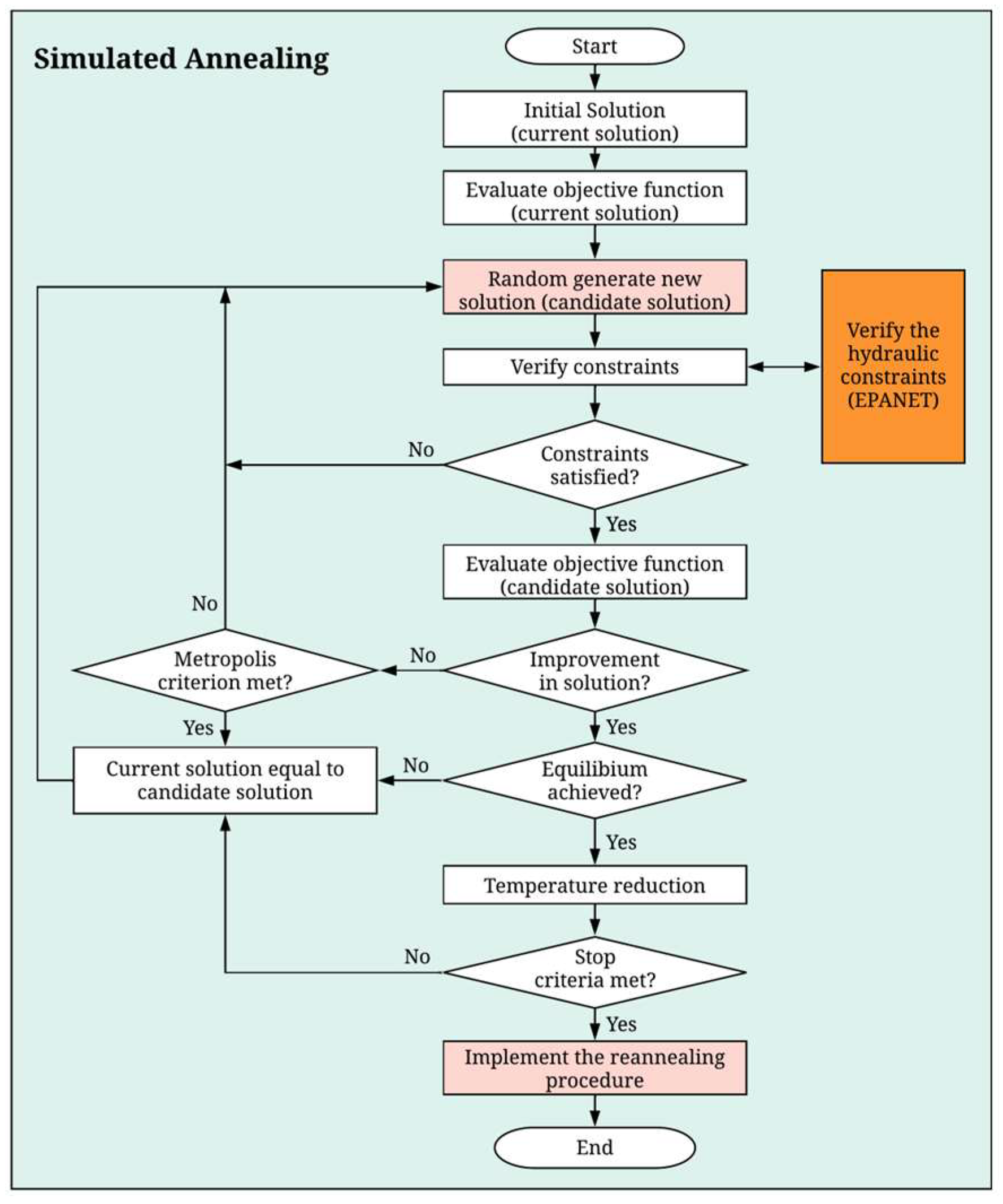

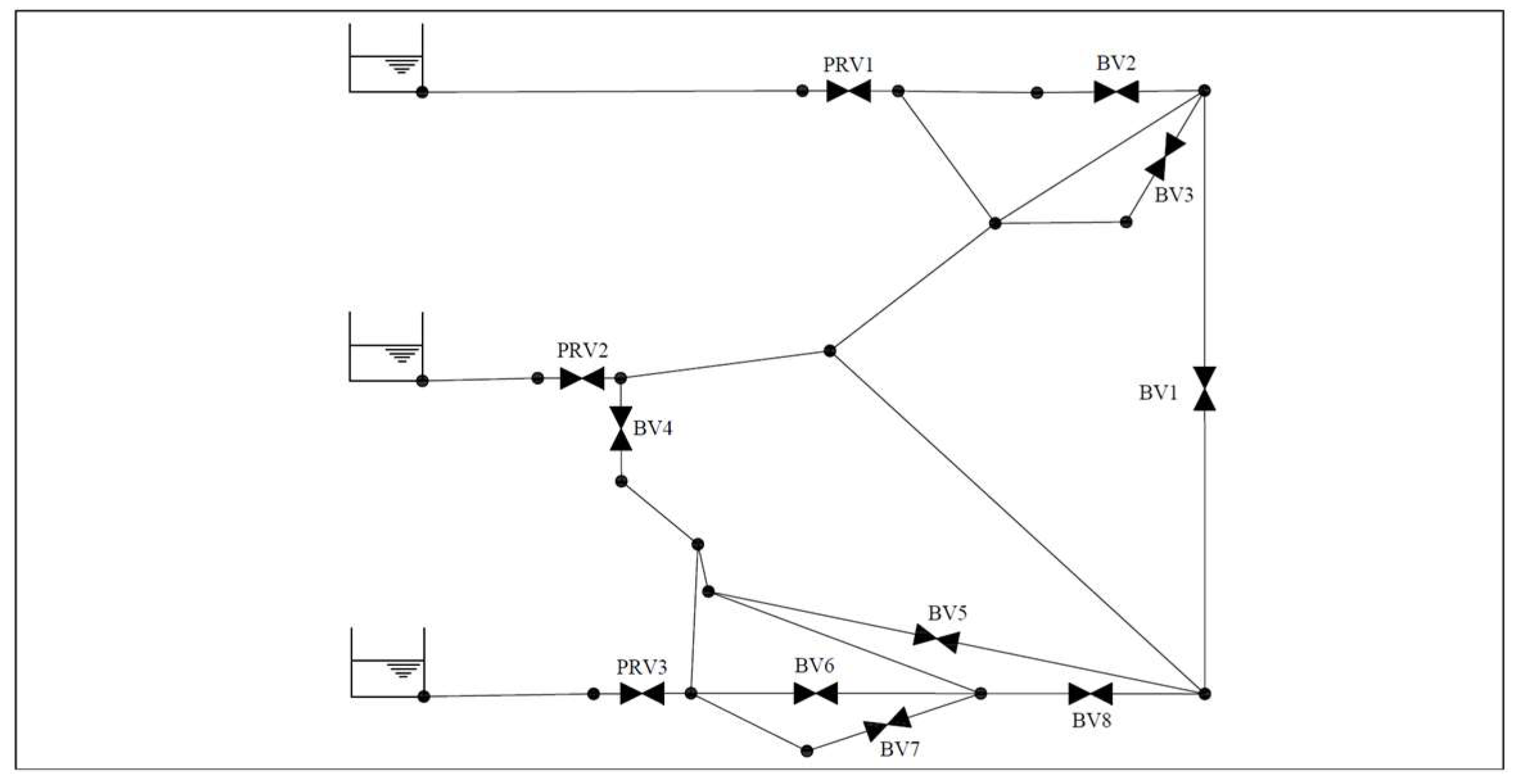

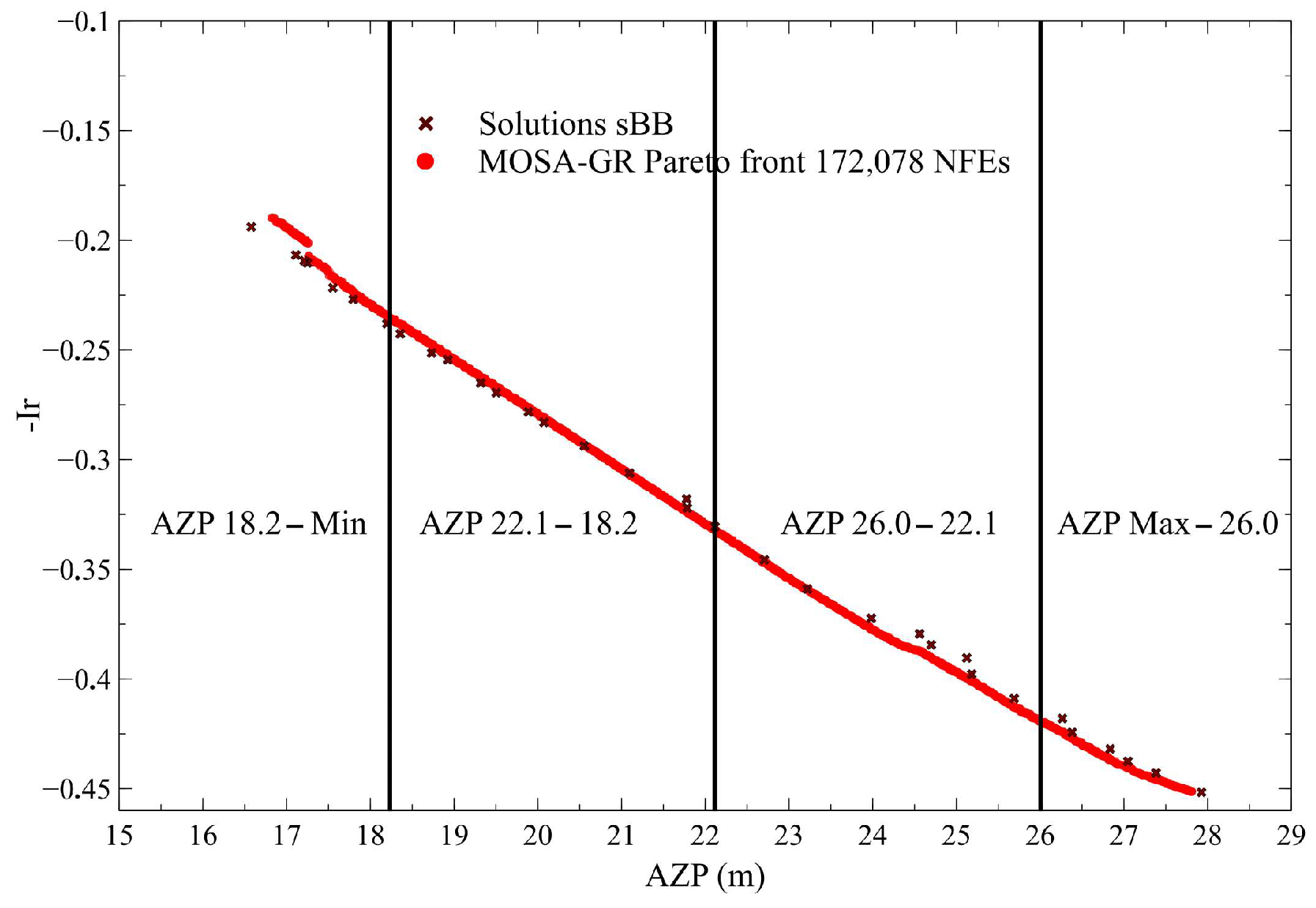
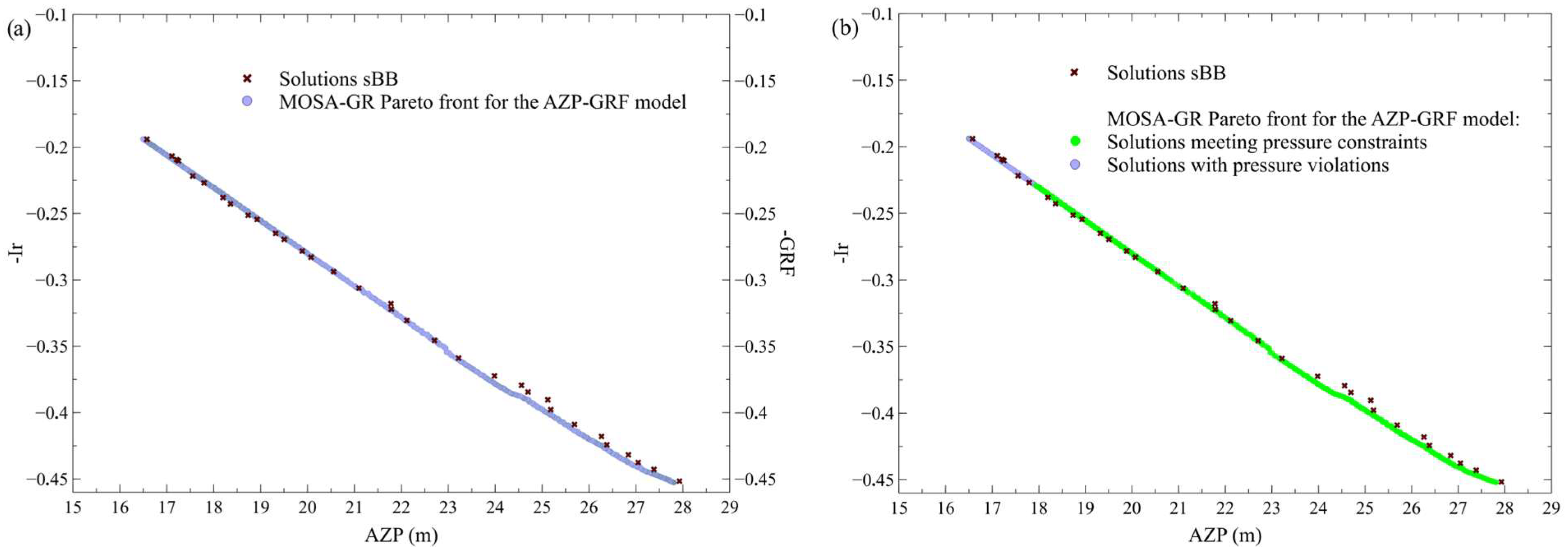
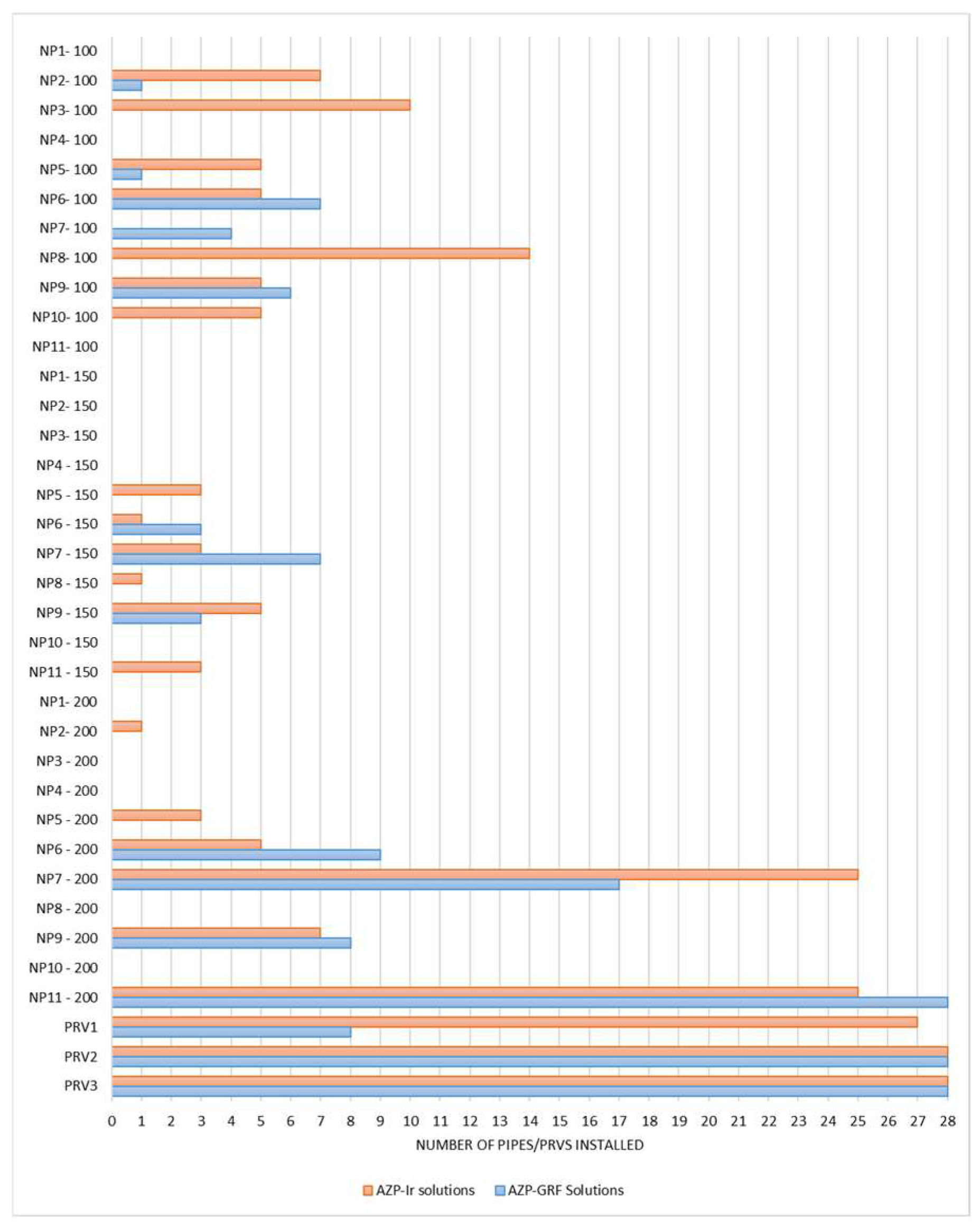



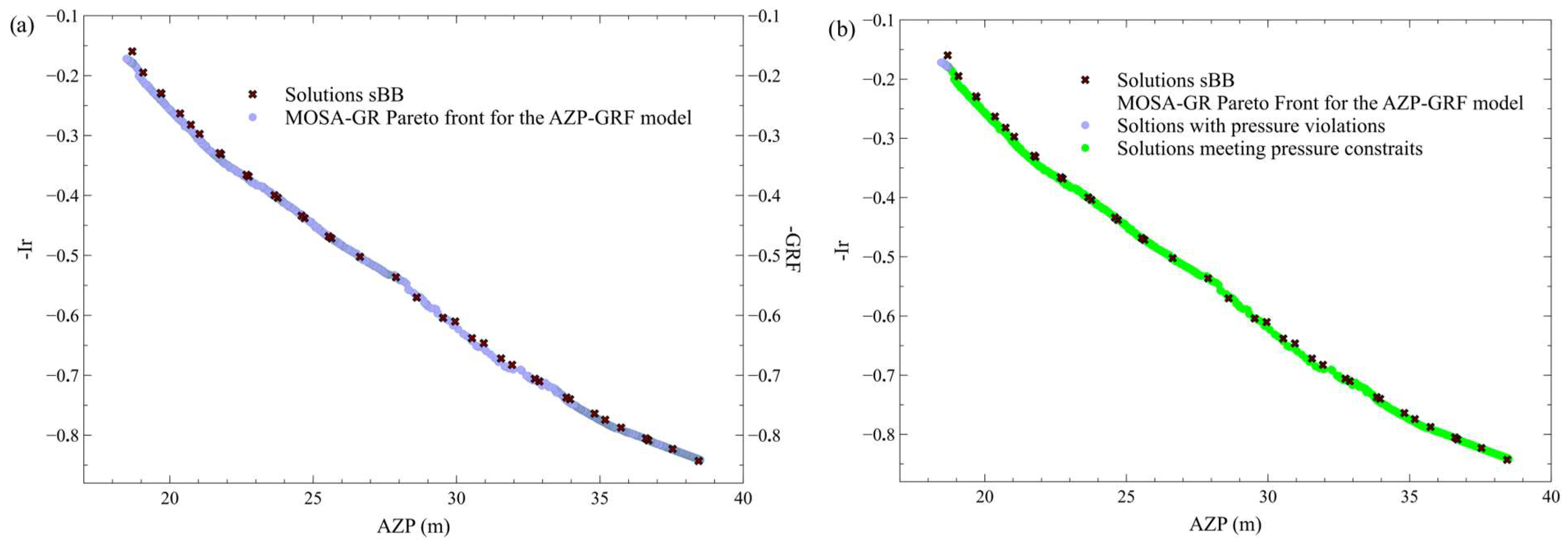
| MOSA-GR | Mathematical Optimization (sBB) | |
|---|---|---|
| Resolution Method | Metaheuristic based on simulated annealing concept, including innovative forms for generation of solutions and intertwined calculations of design and operation of the hydraulic infrastructure. | Application of a scalarization method (e-constraints method), together with global optimization methods, to approximate the Pareto front. Use of a spatial branch-and-bound algorithm to compute upper and lower bounds on the optimal values of the resulting sequence of parametrized single-objective problems in an iterative fashion till stopping criteria are met. Then a Pareto filter algorithm is used to define a “tighter superset of the Pareto front”. |
| Objective functions | The resolution method is applied to both objective functions as they are presented in the bi-objective optimization model. | Non-linear resilience objective function is linearized |
| Constraints | The original constraints included in the bi-objective model are assessed in each iteration of the metaheuristic. No simplification or relaxation is used. | (1) The head losses equation is replaced by its quadratic version. (2) Lower bounds are determined using a MILP formulation, after relaxing the non-convex head-loss equality constraints through a linear outer approximation, by means of a polyhedral envelope method. (3) Upper bounds are obtained by an NLP solver after fixing the values of the binary variables according to the results of the MILP formulation. |
| Stopping criteria | Stopping criteria is based on the evaluation of the quality of the solution found so far. It is based on the number of temperature reductions that are made without the optimum value of current configuration showing any improvement. The temperature parameter is used to control the optimization process by accepting a large number of worse candidate solutions at the beginning of the optimization process and a small number at the end of the process. Furthermore, the minimum value that can be reached by the percentage of solutions accepted can also be used. This procedure is applied to each of the two phases of the SA algorithm [16]. | Iterative process stops when a specified tolerance gap is reached, before the maximum iteration time. The maximum iteration time plays the role of stopping criteria otherwise. |
| NFEs | Computation Time (s) | Number of Solutions |
|---|---|---|
| 75,493 | 287 | 3309 |
| 172,078 | 806 | 4851 |
| 769,891 | 3303 | 6055 |
| 1,553,890 | 6406 | 6420 |
| sBB | MOSA-GR | ||||||||
|---|---|---|---|---|---|---|---|---|---|
| 75,493 NFEs | 172,078 NFEs | 769,891 NFEs | 1,553,890 NFEs | ||||||
| AZP (m) | Ir | AZP (m) | Ir | AZP (m) | Ir | AZP (m) | Ir | AZP (m) | Ir |
| 27.926 | −0.452 | 27.809 | −0.451 | 27.809 | −0.451 | 27.809 | −0.451 | 27.809 | −0.451 |
| 16.577 | −0.194 | 16.827 | −0.190 | 16.827 | −0.190 | 16.827 | −0.190 | 16.827 | −0.190 |
| Min AZP-Max Ir MOSA-GR Solutions | Min AZP-Max GRF MOSA-GR Solutions | ||
|---|---|---|---|
| AZP (m) | Ir | AZP (m) | GRF |
| 18.174 | 0.234 | 18.170 | 0.235 |
| 16.828 | 0.190 | 16.8249 | 0.203 |
| NFEs | Computation Time (s) | Number of Solutions |
|---|---|---|
| 122,095 | 1242 | 2943 |
| 262,073 | 2661 | 4414 |
| 514,879 | 5087 | 5973 |
| 1,023,681 | 13,131 | 7984 |
| sBB | MOSA-GR | ||||||||
|---|---|---|---|---|---|---|---|---|---|
| 122,095 NFEs | 262,073 NFEs | 514,876 NFEs | 1,023,681 NFEs | ||||||
| AZP (m) | Ir | AZP (m) | Ir | AZP (m) | Ir | AZP (m) | Ir | AZP (m) | Ir |
| 38.443 | −0.8434 | 38.499 | −0.842 | 38.499 | −0.841 | 38.499 | −0.841 | 38.499 | −0.841232 |
| 18.689 | −0.1604 | 18.721 | −0.1788 | 18.721 | −0.179 | 18.721 | −0.179 | 18.721 | −0.179 |
Disclaimer/Publisher’s Note: The statements, opinions and data contained in all publications are solely those of the individual author(s) and contributor(s) and not of MDPI and/or the editor(s). MDPI and/or the editor(s) disclaim responsibility for any injury to people or property resulting from any ideas, methods, instructions or products referred to in the content. |
© 2025 by the authors. Licensee MDPI, Basel, Switzerland. This article is an open access article distributed under the terms and conditions of the Creative Commons Attribution (CC BY) license (https://creativecommons.org/licenses/by/4.0/).
Share and Cite
Cunha, M.; Marques, J.; Creaco, E. Water Networks Management: Assessment of Heuristic and Exact Approaches for Optimal Valve Location and Operation Settings Schedule. Water 2025, 17, 3249. https://doi.org/10.3390/w17223249
Cunha M, Marques J, Creaco E. Water Networks Management: Assessment of Heuristic and Exact Approaches for Optimal Valve Location and Operation Settings Schedule. Water. 2025; 17(22):3249. https://doi.org/10.3390/w17223249
Chicago/Turabian StyleCunha, Maria, João Marques, and Enrico Creaco. 2025. "Water Networks Management: Assessment of Heuristic and Exact Approaches for Optimal Valve Location and Operation Settings Schedule" Water 17, no. 22: 3249. https://doi.org/10.3390/w17223249
APA StyleCunha, M., Marques, J., & Creaco, E. (2025). Water Networks Management: Assessment of Heuristic and Exact Approaches for Optimal Valve Location and Operation Settings Schedule. Water, 17(22), 3249. https://doi.org/10.3390/w17223249









